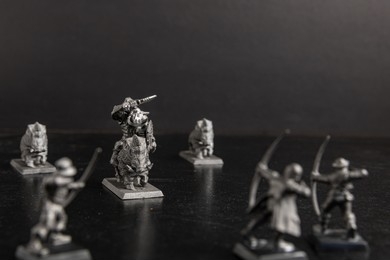INTRODUCTION
Consider for a moment the iconic symbol of Dungeons & Dragons (D&D) - the intricate miniature figures. Have you ever wondered how they came to be? How they evolved and adapted through time, becoming an essential part of the game? Just like a home that changes with generations and their tastes, so too have D&D miniatures transformed.
In this deep-dive, we'll be navigating through the fascinating history and evolution of D&D miniatures. Whether you're a hardcore gaming enthusiast or a curious observer, this blog will provide not just an engaging trip down memory lane, but also an insightful view on how art, culture, and fandoms shape our objects of play.
The Birth of D&D Miniatures
When we first face roll our dice in the D&D world, it's hard to imagine a time without our miniature avatars. Yet, the first rendition of D&D - "Chainmail", didn't come with official miniatures. The creators, Gary Gygax and Dave Arneson, encouraged using whatever was available – young kids might use, say, a Lego man or Peter Pan figure to represent their character. This flexible approach helped catapult the D&D fan community into a dizzying creative sphere where imagination thrived.

Transition into Licensed Miniatures
With the burgeoning popularity of D&D, the market inevitably called for an official touch of magic. Enter: licensed miniatures. Companies like Grenadier Miniatures and Ral Partha, began creating official D&D figures during the late 1970s. These miniatures were typically made of pewter, each with its own character and backstory. They soon became an intricate part of the gameplay, transforming a game of numbers and narratives into a visual spectacle.
Digging Deeper into the Intricacies of Design
Just like a carefully designed house, the construction of a D&D miniature is a process of meticulous planning and execution. This includes scale (1:72 or 25-28mm being standard), choice of material, level of detail, and the availability of customization. Some companies even embrace customization, allowing players to create miniatures that wholly represent their in-game alter ego.
The Digital Revolution and 3D Printing
The onset of 21st century brought a groundbreaking tool in D&D miniature production - 3D printing. This advancement enabled hobbyists to design and print their own miniatures at home. From the simple dice holder to a complex dragon, today any design can be brought to life. Effectively, this technology puts the control back into the hands of the fans, further expanding the possibility of custom creations.
The Pros and Cons of D&D Miniatures
D&D Miniatures have several advantages. They offer visual representation, a tangible asset in the otherwise abstract world of D&D. However, the choice of material, design, and customization bring along price considerations. Some players might find the cost outweighs the benefit, whereas others see the investment in a miniature as a central part of their gaming experience.
Role of Miniatures in Setting the Gaming Culture

Over decades, D&D miniatures have set a significant tone to the gaming culture. The process of choosing, painting, and displaying their miniature can be deeply personal for any player. It is a way to visually express their character's identity and progression in the game. Furthermore, it added a new aspect to the hobby - collecting and showcasing expanding miniature collections, which goes beyond the realm of the game and into personal artistry.
CONCLUSION
From their humble beginnings as makeshift totems to elaborate hand-painted pewter figures and now, 3D customised characters, D&D miniatures have come a long way. They've grown to become a symbol of self-expression, a physical representation of our virtual alter-egos, and a significant subculture within the enchanted realm of D&D.
The evolution of D&D miniatures is a testament to the devotion and creativity of its community, and, just as our homes evolve to reflect our needs, so too does the world of D&D. They are much more than just gameplay accessories; they are the iconic heart of a beloved game that has shaped and continues to shape countless imaginations and narratives around the world.
Comments
Post a Comment